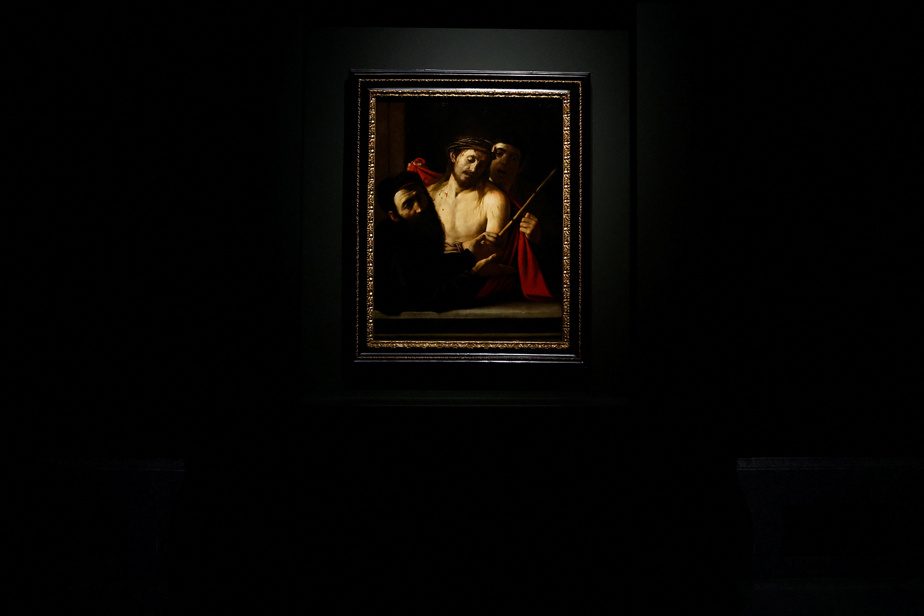(Madrid) Wrongly attributed to a little-known painter, it was almost put up for auction in 2021 for 1,500 euros ($2,220). Finally authenticated, and fully restored, the painting Ecce Homo by Caravaggio is on display for a few months at the Prado Museum in Madrid.
A painting of “extraordinary value” marked by an extraordinary story: this is how the famous museum describes this 400-year-old painting, which will be shown to the general public for nine months, including six in a dedicated room.
An exhibition made possible by the “generosity” of its new owner, who agreed to lend the work temporarily, underlined Monday –– without revealing the identity of this person – the director of the Prado, Miguel Falomir, during a press conference.
Painted between 1605 and 1609, this Ecce Homo (here is the man in Latin) represents Christ, his hands tied and his head surrounded by a crown of thorns, during his presentation to the crowd by the Roman prefect Pontius Pilate, shortly before his crucifixion.
It is one of sixty paintings in the world attributed to the Italian master Michelangelo Merisi da Caravaggio, known as Caravaggio (1571-1610), a painter with a tumultuous life himself forgotten for three centuries before his genius was revived again. recognized in the 1950s.
Unanimous specialists
The rediscovery of this painting is “an important event”, because “it has been more than 45 years” since we had identified a new “work by Caravaggio”, assures David Garcia Cueto, head of the Italian painting department at the Prado. .
According to experts who have studied its history, this small oil on canvas joined the private collection of King Philip IV of Spain in the mid-17e century, before being exhibited in the apartments of his son Charles II.
Bequeathed to the Real Academia de San Fernando, in Madrid, it was allegedly recovered in 1823 by the Spanish statesman and diplomat Evaristo Pérez de Castro in exchange for another painting, before being passed on to his descendants.
The painting, which had fallen into oblivion, found the light again in April 2021. Taking it for the work of a disciple of José de Ribera, a Spanish painter from the beginning of the 17th century.e century and a great admirer of Caravaggio, a Madrid auction house had put a price on it for 1,500 euros.
Alerted by experts, the Prado had sounded the alarm, invoking “sufficient documented and stylistic evidence” to consider that the work was by Caravaggio. In the process, the Spanish Ministry of Culture blocked the operation and banned its export.
An intervention today welcomed by the community of art historians: “the specialists” who looked at this painting established “absolutely unanimously” that it was a painting by the Italian master, insists David Garcia Cueto.
” Masterpiece “
Among the experts who participated in the authentication of this Ecce Homo – a scene from the Passion of Christ regularly represented in classical art – features Maria Cristina Terzaghi, professor of modern art at the Italian University Roma Tre.
The painting “was subjected to x-ray images” and a thorough “examination”, particularly during its restoration, said Monday the academic, who traveled to Madrid as soon as the sale was blocked to examine the painting.
However, all these elements show that it is “indeed a masterpiece by Caravaggio”, added the specialist, evoking pell-mell the nature of the brushstrokes, the composition of the painting or the expressiveness of the characters, all typical of the Italian chiaroscuro specialist.
What will happen to this painting once the nine months of exhibition have passed? According to Spanish media, the painting – which was bought for 36 million euros by its new owner, a British citizen residing in Spain – could remain on display to the general public.
Ecce Homo “will not end up in the home of its buyer”, because the latter wants it to join “public collections, for the moment, in the form of a loan”, assured Jorge Coll, manager of the gallery which was responsible for its sale, on a daily basis El País.
On the Prado side, however, we say we are cautious. “It’s a private work, so its owner will have the last word,” recalls Miguel Falomir.
